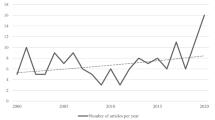Abstract
Forecasting studies, which are conducted in all the developed economies of the world, are one of the fastest growing applications of scientometrics. Currently, in Russia there is a formed state Technology Foresight System, which creates a new format for the future development of research and for interaction among the key players in the national innovation system. Considering the new institutional environment of forecasting projects in Russia and the international trends in the relevant research environments, scientometric methods for the monitoring, analysis, and forecasting of the development of science and technology are identified as one of the most important methods. Specific demands and trends, which will soon have a substantial impact on the entire area of scientometrics, are formulated.
Similar content being viewed by others
References
Sokolov, A.V., Foresight: A look into the future, Foresight-Russia, 2007, vol. 1(1), pp. 8–15.
Miles, I., New horizons and challenges for future-oriented technology analysis, Proc. 1st Int. Seville Sem. on Future-Oriented Technology Analysis: Impact of FTA Approaches on Policy and Decision-Making, Seville, 2002.
Freeman, C., Technology Policy and Economic Performance: Lessons from Japan, London: F. Pinter, 1987.
Gaponenko, N.V., Forsait. Teoriya. Metodologiya. Opyt (Foresight. Theory. Methodology. Experience), Moscow: YuNITI-DANA, 2008.
Popper, R., Methodology: Foresight practices and tools, in International Handbook on Foresight and Science Policy: Theory and Practice, Georghiou, l. et al., Eds., London: Edward Elgar, 2006.
European Commission Facing the Future: Time for the EU to Meet Global Challenges, Luxembourg: Publications Office of the European Union, 2010.
Christensen, M., Roth, E., and Anthony, S., Seeing what’s Next: Using Theories of Innovation to Predict Industry Change, Cambridge: Harvard Business, 2004.
Sokolov, A.V. and Chulok, A.A., Russian Science and Technology Foresight — 2030: Key Features and First Results, Foresight-Russia, 2012, vol. 6(1), pp. 12–25.
“Triple miracle” sees huge rise in EU funds for frontier research. http://www.timeshighereducation.co.uk/416952.article
Ruotsalainen, L., Data mining tools for technology and competitive intelligence. http://www.vtt.fi/inf/pdf/tiedotteet/2008/T2451.pdf
Kirsch, G. and Brown, C., Using patents in competitive intelligence SCIP Compet. Intel. Mag., 2006, vol. 9(1), pp. 17–21.
Cabena, P., Hadjinian, P., Stadler, R., Verhess, J., and Zanasi, A., Discovering Data Mining: from Concept to Implementation, New York: Englewood Cliffs, 1997.
Hehenberger, M. and Coupet, P., Text mining applied to patent analysis, Proc. 1998 Annual Meeting of American Intellectual Property Law Association (AIPLA), Arlington, 1998.
Krier, M. and Zacca, F., Automatic categorization applications at the European patent office, World Patent Inf., 2002, vol. 24(3), pp. 187–196.
Kondrat’ev, N.D., Bol’shie tsikly kon“yunktury i teoriya predvideniya (Large Cycles of Conjuncture and Theory of Foresight), Moscow: Ekonomika, 2002.
Shumpeter, J.A., Teoriya ekonomicheskogo razvitiya (Issledovanie predprinimatel’skoi pribyli, kapitala, kredita, protsenta i tsikla kon“yunktury) (Theory of Economic Development (Study of Profit of Enterprise, Capital, Credit, Percent and Conjuncture Cycle), London: George Alien and Unwin, 1952; Moscow: Progress, 1982.
Perez, C., Technological Revolutions and Financial Capital: The Dynamics of Bubbles and Golden Ages, London: Elgar, 2002.
Glaz’ev, S. and Mikerin, G., Dlinnye volny NTP i sotsial’no-ekonomicheskoe razvitie, (Long Waves: Scientific and Technical Progress and Social-Economic Development), Moscow: Nauka, 1989.
Sciverse. http://www.sciverse.com
Web of Knowledge. http://wokinfo.com/
Khomchuk, O.P., Review of screen technology development. http://www.podberi.tv/review/479
Article on the NSU Ro 80 motor car. http://ru.wikipedia.org/wiki/NSU_Ro_80
Georghiou, L., Cameron, H., Keenan, M., Miles, I., and Saritas, O., An Evaluation of the UK Foresight Program: Final Report, Manchester: Univ. Manchester, 2006.
Haegeman, K., Marinelli, E., Scapolo, F., Ricci, F., and Sokolov, A., Quantitative and qualitative approaches in future-oriented technology analysis (FTA): From combination to integration? Technol. Forecasting Soc. Change, 2013, No 80, pp. 386–397.
Author information
Authors and Affiliations
Corresponding author
Additional information
Original Russian Text © V.R. Mesropyan, M.V. Ovsyannikov, 2014, published in Nauchno-Technicheskaya Informatsiya, Seriya 1, 2014, No. 1, pp. 19–27.
About this article
Cite this article
Mesropyan, V.R., Ovsyannikov, M.V. Prospects for the application of scientometric methods for forecasting. Sci. Tech.Inf. Proc. 41, 38–46 (2014). https://doi.org/10.3103/S0147688214010080
Received:
Published:
Issue Date:
DOI: https://doi.org/10.3103/S0147688214010080




